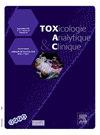药物促进性侵犯(DFSA)在化学性环境:在确定归咎的挑战
IF 1.7
Q4 TOXICOLOGY
引用次数: 0
摘要
目的:介绍两例在化学性性行为中因摄入新型精神活性物质(NPS)而导致的DFSA。在第一起案件中,受害人(15 岁男性)喝下了嫌犯提供的一杯酒,并对随后发生的事件完全失忆。现场缴获了两个瓶子、一个注射器、散装粉末、两个粉末轨道和晶体。在第二起案件中,受害人(30 岁,男性)在药交会上自愿服用 3-MMC 后,报告被注射了 3-MMC,随后昏迷并住院治疗。结果 在第一起案件中,受害人的血液分析(事件发生后大约 5 小时采样)显示吸收了伽马--羟丁酸(31 微克/毫升),尿液分析(194 微克/毫升)证实了这一点。未检测到酒精。只在尿液中检测到阴离子(3-CMC 和 3-MMC)。嫌疑人的血液中检测到他达拉非(0.08 μg/mL),尿液中检测到卡西酮(3-CMC 和 3-MMC)。两个瓶子中都含有 GBL(93.4%和 2.3%),注射器中含有微量 GBL,晶体中含有 3-CMC(94.7%),粉末中含有 3-MMC(92.8%),两个粉轨中都发现有 3-CMC(91.7%)。在第二起案件中,受害人的血液分析(在事件发生后约 40 小时采样)显示出甲型 PHP(估计为 100ng/mL)、羟考酮(3.4ng/mL)、地西泮(估计为 121ng/mL)及其代谢物。在尿液中也检测到了甲型 PHP、羟考酮、地西泮及其代谢物,以及咪达唑仑。在这两起案件中,都发现了化性环境中常见的各种物质:磷酸二酯酶抑制剂、卡西酮、伽马--羟丁酸。在第一起案件中,受害人声称只喝了一杯酒。根据分析结果,受害人摄入了 GBL/GHB 和两种不同的卡西酮,可能是在她不知情的情况下摄入的。虽然卡西酮是兴奋剂,但酒精和 GBL/GHB 的结合可以解释受害人所描述的昏厥。在从嫌疑人身上查获的产品中发现了受害人样本中鉴定出的所有物质。在第二起案件中,没有检测到申报的 3-MMC 用途,这可能是由于在采样前 40 小时的间隔期内,3-MMC 已被消除。受害者否认服用了甲型 PHP,这表明在事件发生之前或同时服用了甲型 PHP。地西泮和咪达唑仑是在医院施用的,羟考酮的来源尚不清楚,但考虑到该物质的半衰期,很可能与事件不是同时发生的。受害者的服用申报与分析结果之间的差异可能有多种来源:不知情的服用、非自愿服用(不同成分、杂质等)、错误或虚假申报。本文章由计算机程序翻译,如有差异,请以英文原文为准。
Drug Facilitated Sexual Assault (DFSA) in a chemsex context: Challenges in determining imputability
Aim
Presenting two cases of DFSA by New Psychoactive Substance (NPS) intake in a chemsex context. In the first case, the victim (15-year-old male) consumed a single glass of alcohol offered by the suspect and experienced complete amnesia of subsequent events. On site, two bottles, a syringe, powder in bulk, two powder rails and crystals were seized. In the second case, the victim (30-year-old male), following voluntary consumption of 3-MMC in a chemsex context, reported being injected with 3-MMC, which was followed by a black-out and hospitalization.
Method
Biological samples (blood and urine) were analysed by GC-MS, LC-MS/MS and LC-HRMS, seized products by GC-MS, LC-DAD and LC-MS/MS.
Results
In the first case, victim's blood analysis (sampled approximatively 5 hours post event) revealed GHB absorption (31 μg/mL), confirmed by urine analysis (194 μg/mL). No alcohol was detected. Cathinones (3-CMC and 3-MMC) were identified in urine only. For the suspect, tadalafil (0.08 μg/mL) was detected in blood and cathinones (3-CMC and 3-MMC) in urine. Both bottles contained GBL (93.4% and 2.3%), the syringe carried traces of GBL, the crystals consisted 3-CMC (94.7%), the powder 3-MMC (92.8%) and both powder rails were found to be 3-CMC (91.7%). In the second case, victim's blood analysis (sampled approximately 40 hours post event) revealed alpha-PHP (estimated at 100ng/mL), oxycodone (3.4ng/mL), diazepam (estimated at 121ng/mL) and its metabolites. In urine, alpha-PHP, oxycodone, diazepam and its metabolites were also detected, as was midazolam. In both cases, various substances commonly found in chemsex contexts were identified: phosphodiesterase inhibitors, cathinones, GHB. In the first case, the victim claimed consuming only one glass of alcohol. According to the results of the analysis, the victim ingested GBL/GHB and two different cathinones, possibly without her knowing. Although cathinones are stimulants, the combination of alcohol and GBL/GHB could explain the blackout described by the victim. The substances identified in the victim's samples were all found in the products seized from the suspect. In the second case, the declared 3-MMC use was not detected, possibly due to its elimination in the 40-hour interval before sampling. The presence of alpha-PHP, which the victim denied consuming, suggests prior or simultaneous administration during the event. Diazepam and midazolam were administered at the hospital, and oxycodone's origin remains unclear but is probably not contemporaneous with the events, given the substance's half-life.
Conclusion
The number and diversity of substances likely to provoke DFSA in a chemsex context make the handling of these potential cases complicated. Discrepancies between victims’ consumption declarations and analytical results can have various origins: unknowing administration, involuntary consumption (different composition, impurity, etc.), erroneous or false declarations.
These factors significantly challenge the formal determination of DFSA cases.
求助全文
通过发布文献求助,成功后即可免费获取论文全文。
去求助

 求助内容:
求助内容: 应助结果提醒方式:
应助结果提醒方式:


